Mode I Fracture Toughness of Graphene Reinforced Nanocomposite Film on Al Substrate
Abstract
:1. Introduction
2. Materials and Methods
2.1. Nanocomposite Preparation
2.2. Fracture Surface Morphology
2.3. Mode I Fracture Toughness
3. Results and Discussions
3.1. Tensile Mechanical Properties
3.2. Fracture Toughness
4. Conclusions
Author Contributions
Funding
Data Availability Statement
Conflicts of Interest
References
- Novoselov, K.S.; Geim, A.K.; Morozov, S.V.; Jiang, D.; Zhang, Y.; Dubonos, S.V.; Grigorieva, I.V.; Firsov, A.A. Electric field effect in atomically thin carbon films. Science 2004, 306, 666–669. [Google Scholar] [CrossRef] [Green Version]
- Geim, A.K.; Novoselov, K.S. The rise of graphene. Nat. Mater. 2007, 6, 183–191. [Google Scholar] [CrossRef]
- Rafiee, M.; Rafiee, J.; Wang, Z.; Song, H.; Yu, Z.-Z.; Koratkar, N. Enhanced Mechanical Properties of Nanocomposites at Low Graphene Content. ACS Nano 2009, 3, 3884–3890. [Google Scholar] [CrossRef] [PubMed]
- Rafiee, M.; Rafiee, J.; Yu, Z.-Z.; Koratkar, N. Buckling resistant graphene nanocomposites. Appl. Phys. Lett. 2009, 95, 223103. [Google Scholar] [CrossRef]
- Chandrasekaran, S.; Sato, N.; Tölle, F.; Mülhaupt, R.; Fiedler, B.; Schulte, K. Fracture toughness and failure mechanism of graphene based epoxy composites. Compos. Sci. Technol. 2014, 97, 90–99. [Google Scholar] [CrossRef]
- Prolongo, S.G.; Jimenez-Suarez, A.; Moriche, R.; Ureña, A. In situ processing of epoxy composites reinforced with graphene nanoplatelets. Compos. Sci. Technol. 2013, 86, 185–191. [Google Scholar] [CrossRef]
- Teng, C.-C.; Ma, C.-C.M.; Lu, C.-H.; Yang, S.-Y.; Lee, S.-H.; Hsiao, M.-C.; Yen, M.-Y.; Chiou, K.-C.; Lee, T.-M. Thermal conductivity and structure of non-covalent functionalized graphene/epoxy composites. Carbon 2011, 49, 5107–5116. [Google Scholar] [CrossRef]
- Wang, J.; Hu, H.; Wang, X.; Xu, C.; Zhang, M.; Shang, X. Preparation and mechanical and electrical properties of graphene nanosheetsepoly (methyl methacrylate) nanocomposites via in situ suspension polymerization. J. Appl. Polym. Sci. 2011, 122, 1866–1871. [Google Scholar] [CrossRef]
- Zhao, X.; Zhang, Q.; Chen, D.; Lu, P. Enhanced Mechanical Properties of Graphene-Based Poly(vinyl alcohol) Composites. Macromolecules 2010, 43, 2357–2363. [Google Scholar] [CrossRef]
- Liang, J.; Huang, Y.; Zhang, L.; Wang, Y.; Ma, Y.; Guo, T.; Chen, Y. Molecular-Level Dispersion of Graphene into Poly(vinyl alcohol) and Effective Reinforcement of their Nanocomposites. Adv. Funct. Mater. 2009, 19, 2297–2302. [Google Scholar] [CrossRef]
- Wei, Y.; Hu, X.; Jiang, Q.; Sun, Z.; Wang, P.; Qiu, Y.; Liu, W. Influence of graphene oxide with different oxidation levels on the properties of epoxy composites. Compos. Sci. Technol. 2018, 161, 74–84. [Google Scholar] [CrossRef]
- Tang, L.-C.; Wan, Y.-J.; Yan, D.; Pei, Y.-B.; Zhao, L.; Li, Y.-B.; Wu, L.-B.; Jiang, J.-X.; Lai, G.-Q. The effect of graphene dispersion on the mechanical properties of graphene/epoxy composites. Carbon 2013, 60, 16–27. [Google Scholar] [CrossRef]
- Rafiee, M.A.; Rafiee, J.; Srivastava, I.; Wang, Z.; Song, H.; Yu, Z.Z.; Koratkar, N.N. Fracture and Fatigue in Graphene Nano-composites. Small 2013, 6, 179–183. [Google Scholar] [CrossRef]
- Fang, M.; Zhang, Z.; Li, J.; Zhang, H.; Lu, H.; Yang, Y. Constructing hierarchically structured interphases for strong and tough epoxy nanocomposites by amine-rich graphene surfaces. J. Mater. Chem. 2010, 20, 9635–9643. [Google Scholar] [CrossRef]
- Bagheri, R.; Marouf, B.T.; Pearson, R.A. Rubber-Toughened Epoxies: A Critical Review. Polym. Rev. 2009, 49, 201–225. [Google Scholar] [CrossRef]
- Francis, B.; Thomas, S.; Asari, G.V.; Ramaswamy, R.; Jose, S.; Rao, V.L. Synthesis of hydroxyl-terminated poly(ether ether ketone) with pendent tert-butyl groups and its use as a toughener for epoxy resins. J. Polym. Sci. Pol. Phys. 2006, 44, 541–556. [Google Scholar] [CrossRef]
- Johnsen, B.; Kinloch, A.; Mohammed, R.; Taylor, A.; Sprenger, S. Toughening mechanisms of nanoparticle-modified epoxy polymers. Polymer 2007, 48, 530–541. [Google Scholar] [CrossRef]
- Wang, K.; Chen, L.; Wu, J.; Toh, M.L.; He, C.; Yee, A.F. Epoxy Nanocomposites with Highly Exfoliated Clay: Mechanical Properties and Fracture Mechanisms. Macromolecules 2005, 38, 788–800. [Google Scholar] [CrossRef]
- Cha, J.; Jun, G.H.; Park, J.K.; Kim, J.C.; Ryu, H.J.; Hong, S.H. Improvement of modulus, strength and fracture toughness of CNT/Epoxy nanocomposites through the functionalization of carbon nanotubes. Compos. Part B Eng. 2017, 129, 169–179. [Google Scholar] [CrossRef]
- Kang, W.-S.; Rhee, K.Y.; Park, S.-J. Influence of surface energetics of graphene oxide on fracture toughness of epoxy nano-composites. Compos. Part B 2017, 114, 175–183. [Google Scholar] [CrossRef]
- Geng, Y.; Liu, M.Y.; Li, J.; Shi, X.M.; Kim, J.K. Effects of surfactant treatment on mechanical and electrical properties of CNT/epoxy nanocomposites. Compos. Part A Appl. Sci. Manuf. 2008, 39, 1876–1883. [Google Scholar] [CrossRef]
- Lee, C.; Wei, X.; Kysar, J.W.; Hone, J. Measurement of the elastic properties and intrinsic strength of monolayer graphene. Science 2008, 321, 385–388. [Google Scholar] [CrossRef] [PubMed]
- Mefford, C.H.; Qiao, Y.; Salviato, M. Failure behavior and scaling of graphene nanocomposites. Compos. Struct. 2017, 176, 961–972. [Google Scholar] [CrossRef] [Green Version]
- Chandrasekaran, S.; Seidel, C.; Schulte, K. Preparation and characterization of graphite nano-platelet (GNP)/epoxy nano-composite: Mechanical, electrical and thermal properties. Eur. Polym. J. 2013, 49, 3878–3888. [Google Scholar] [CrossRef]
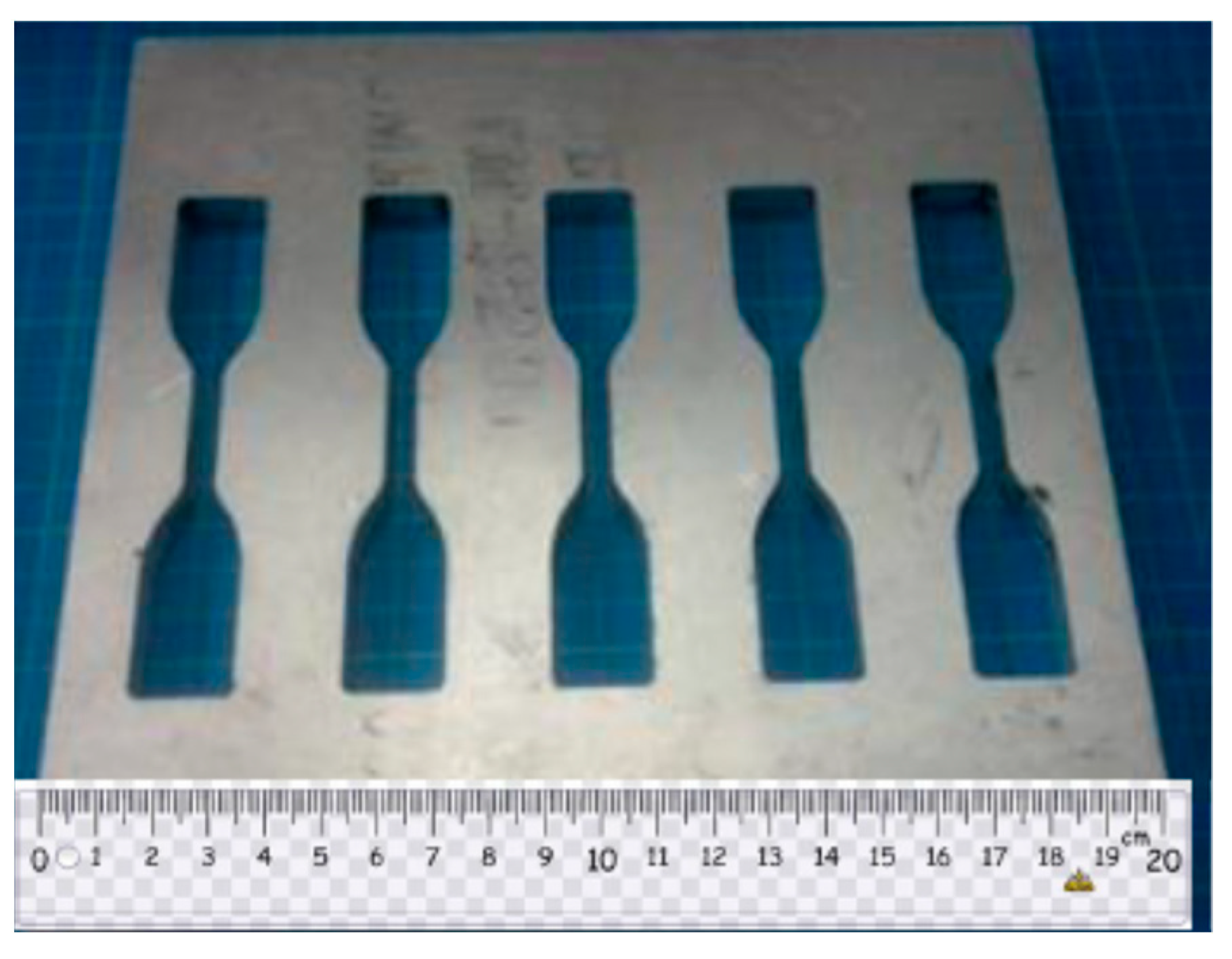
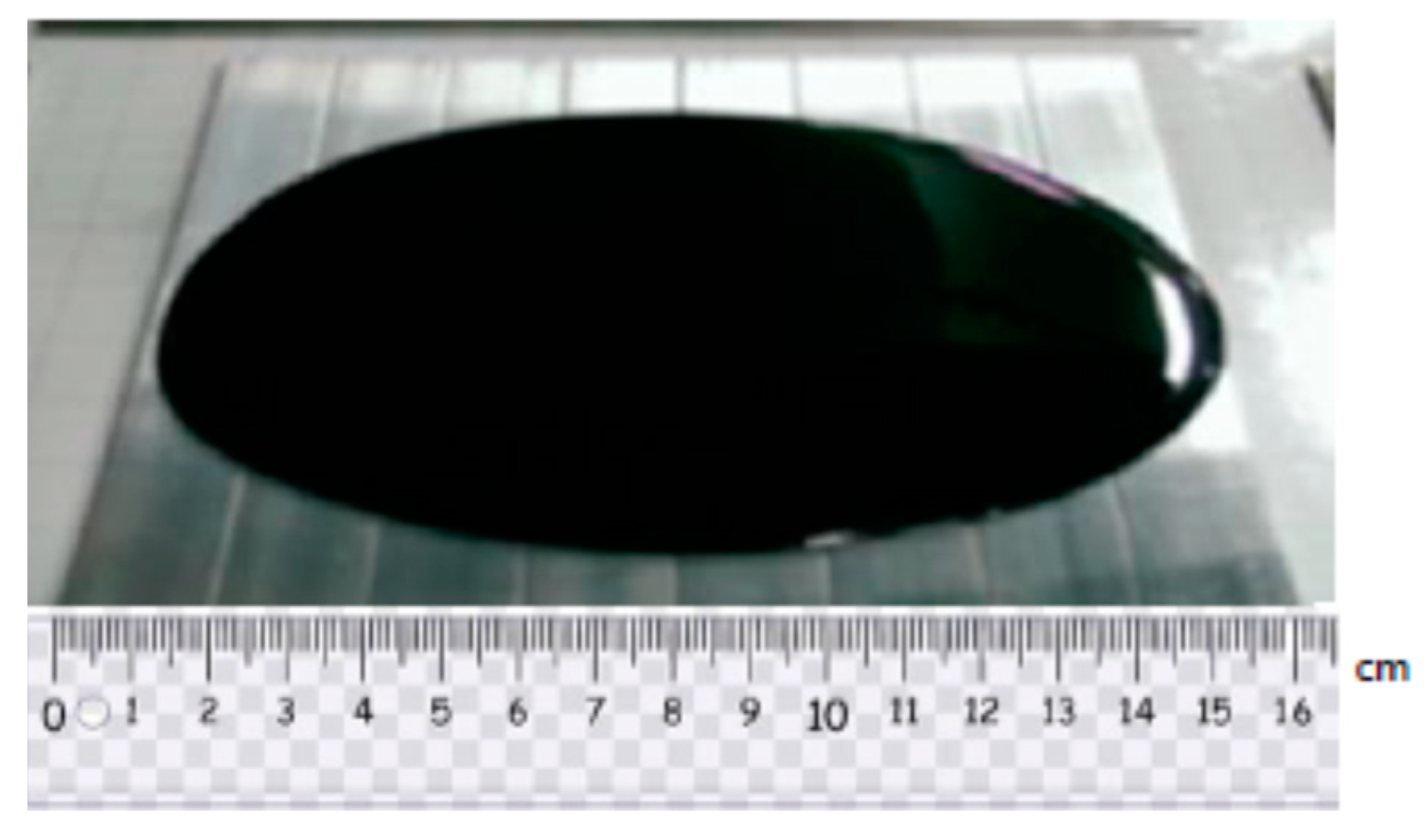
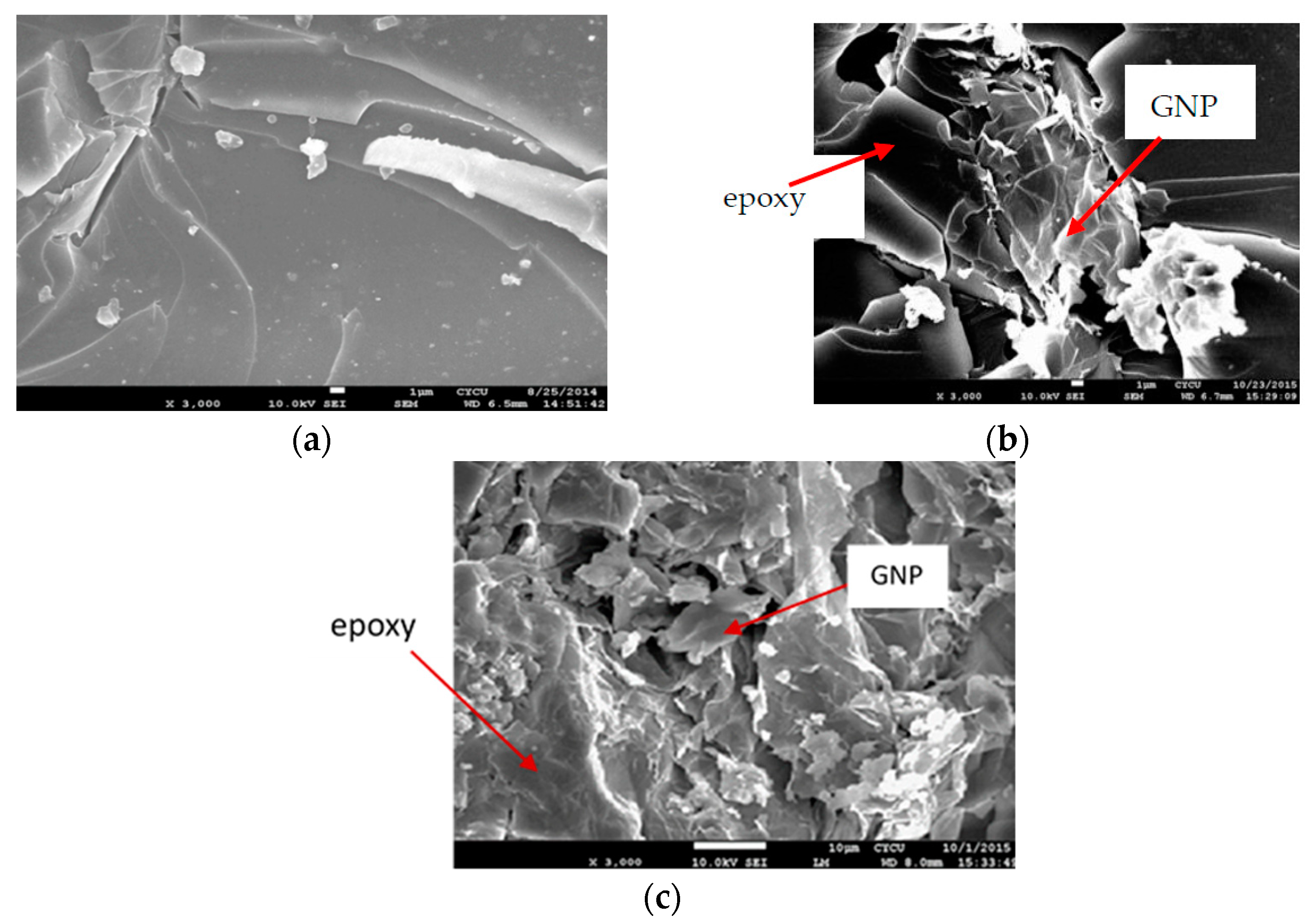
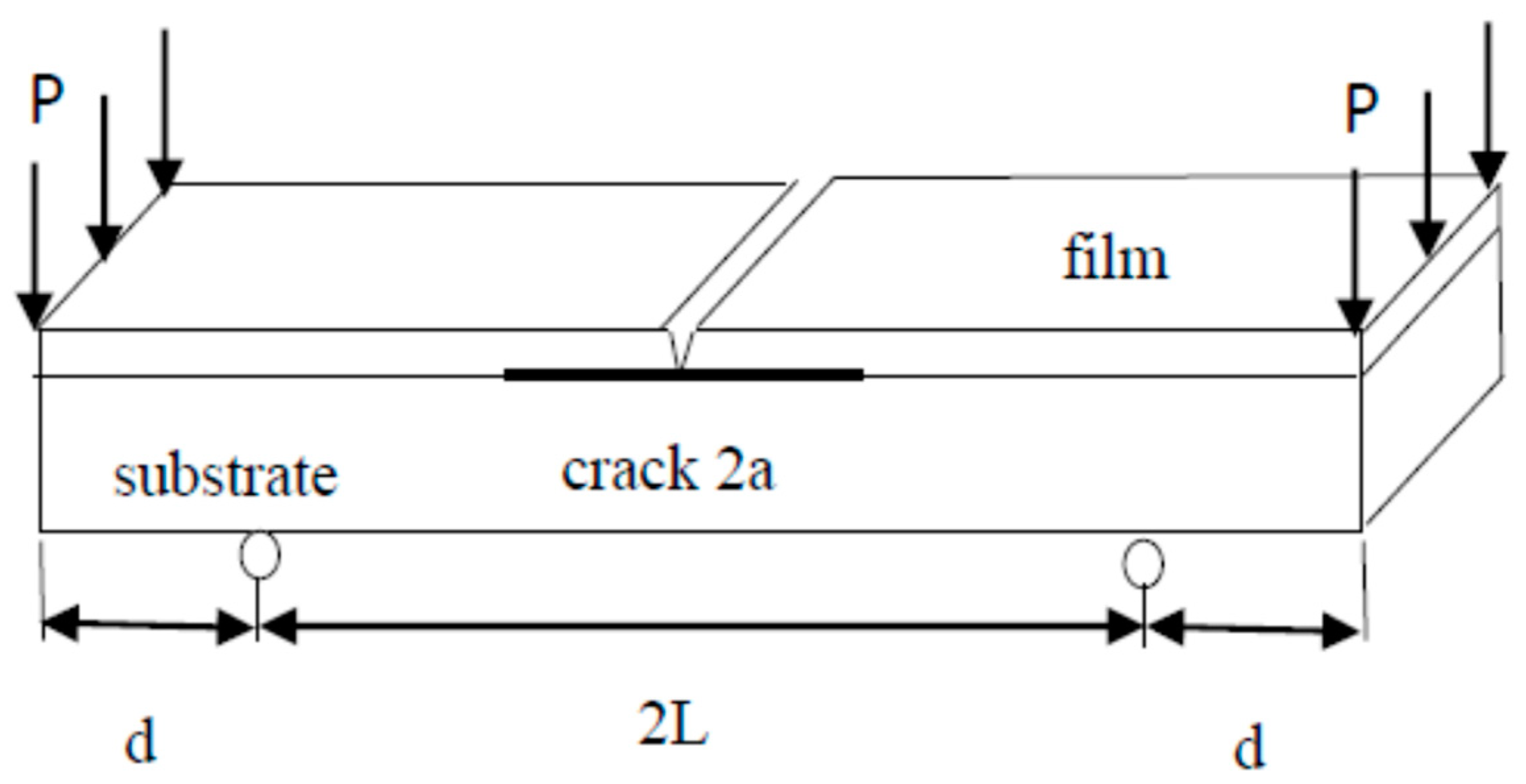

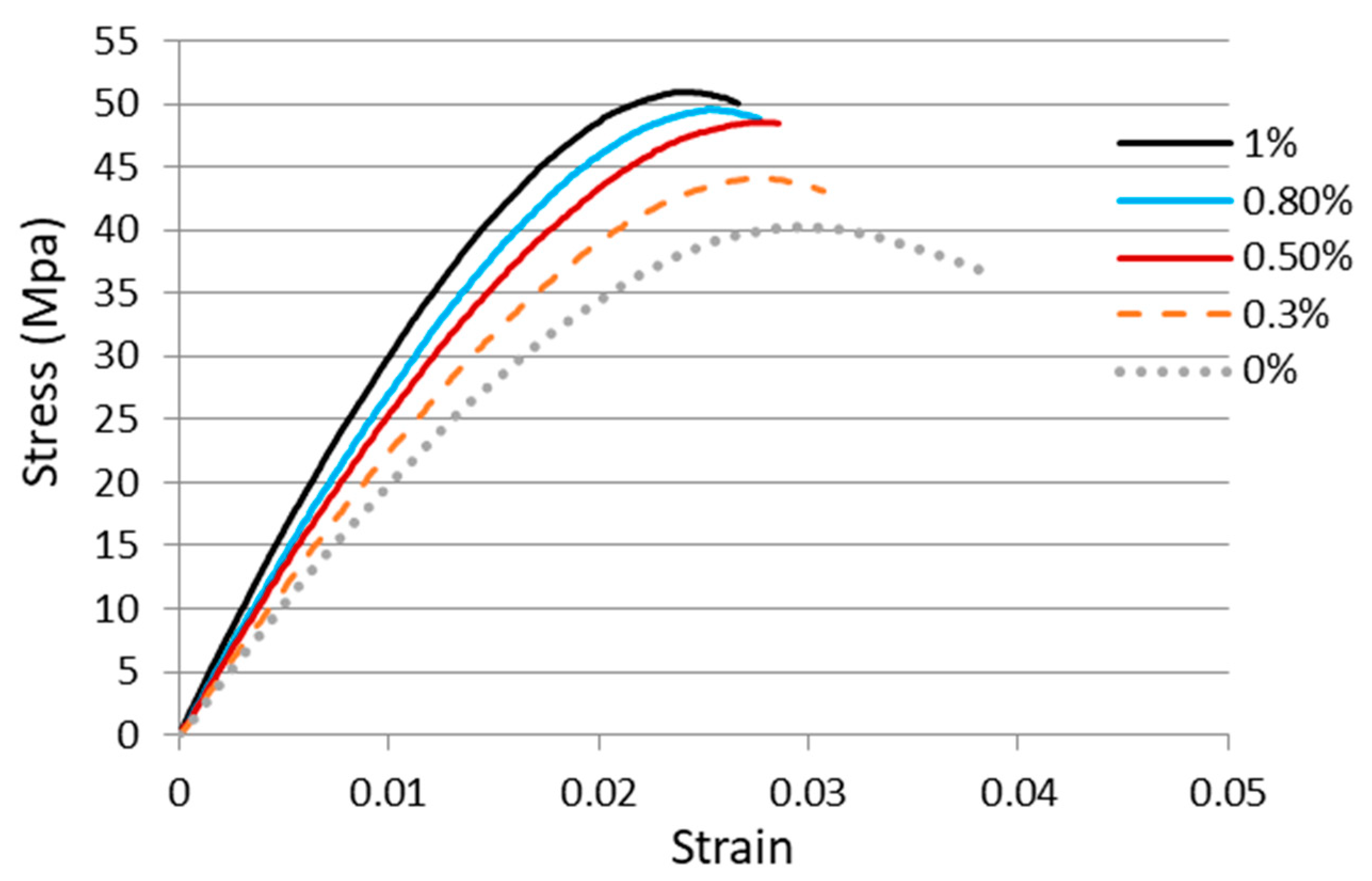
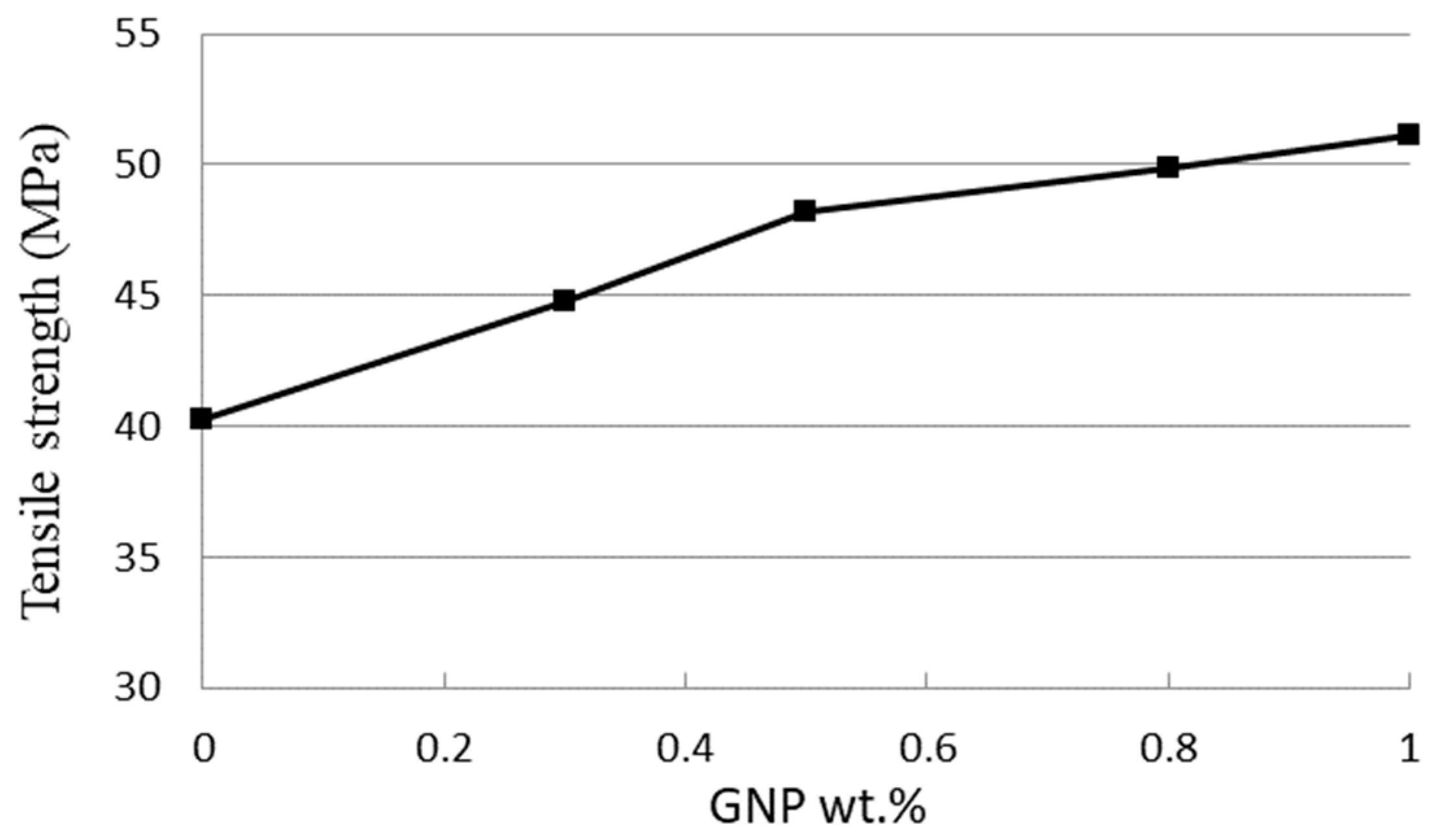
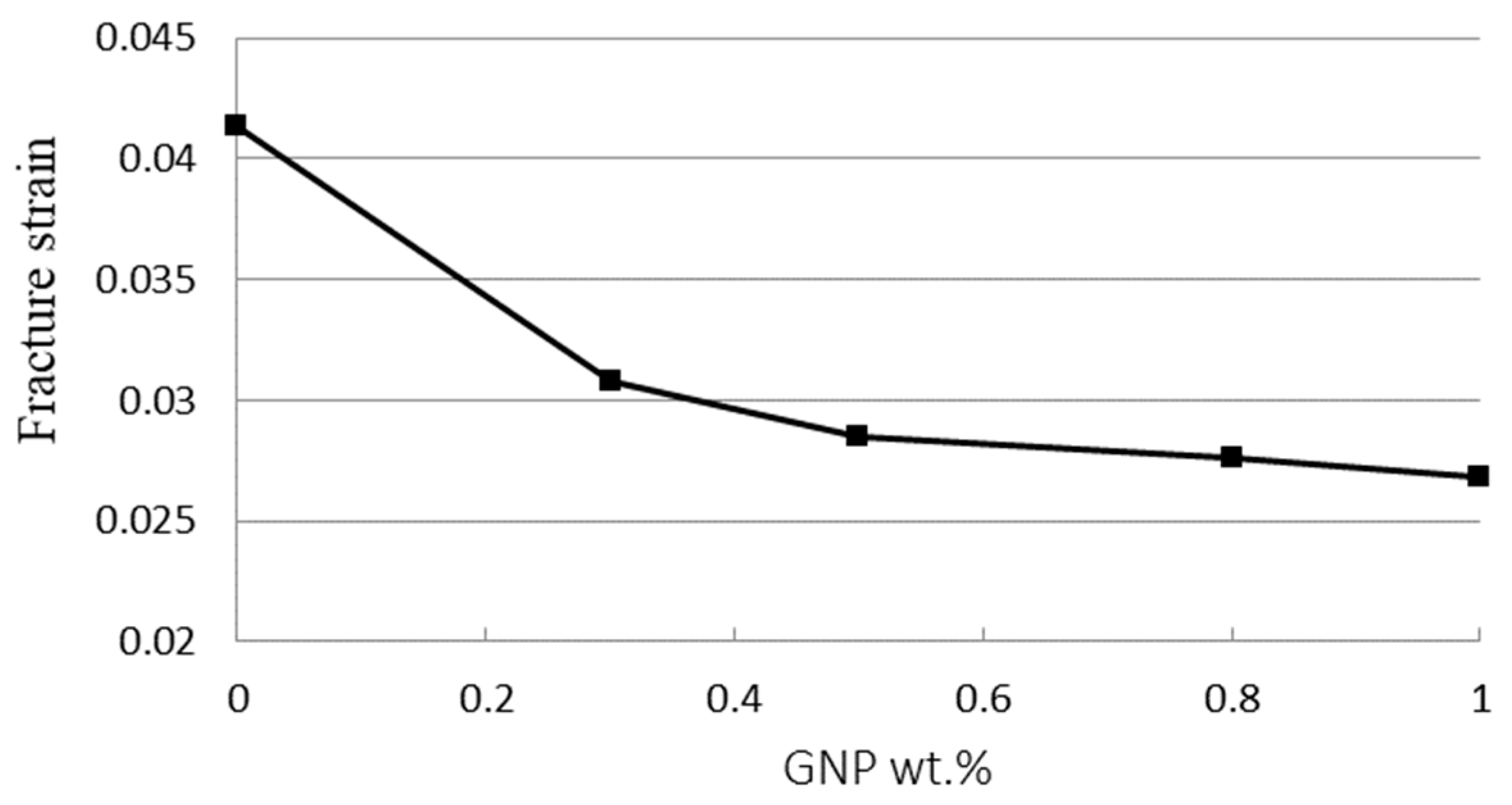

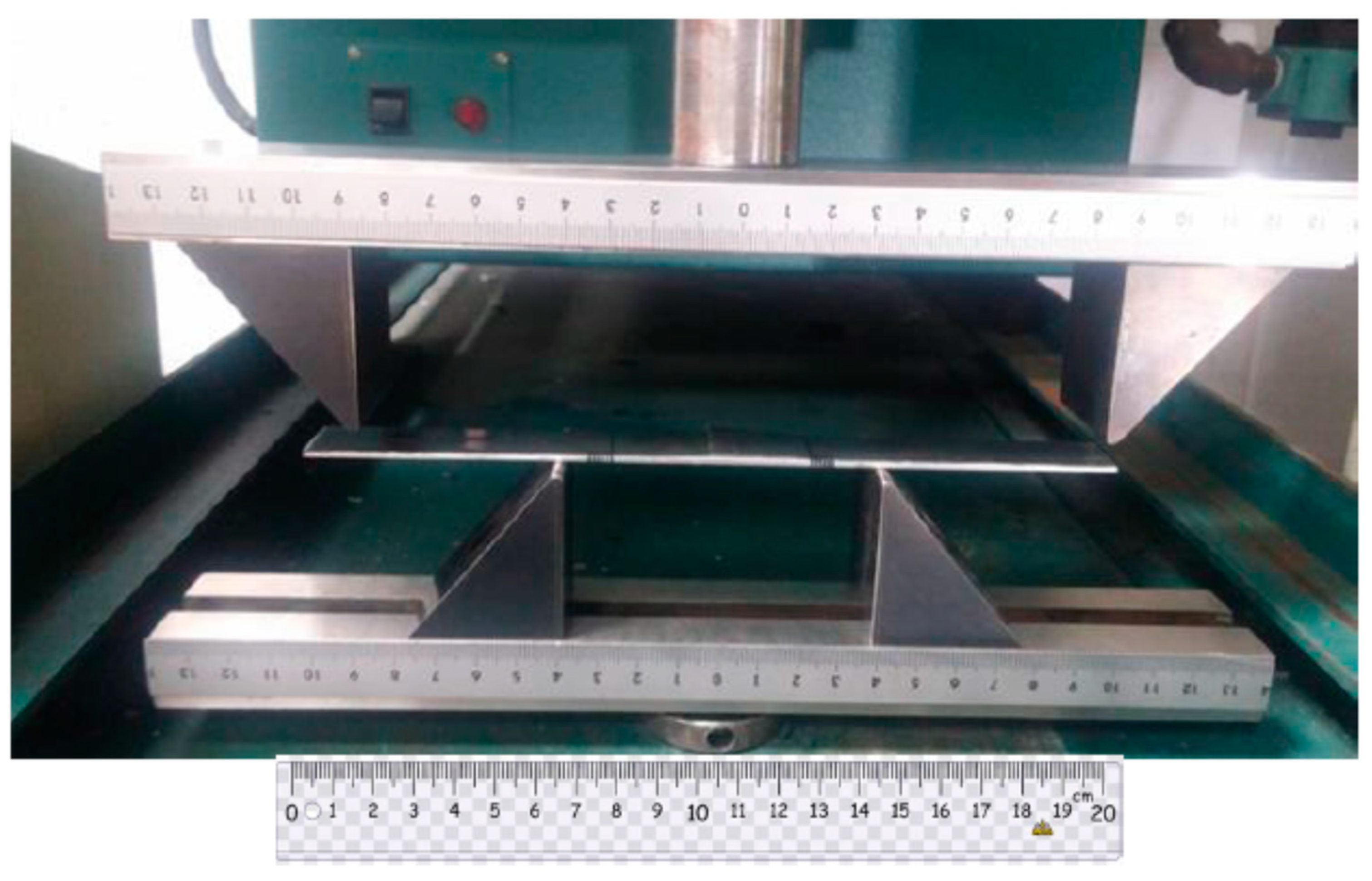
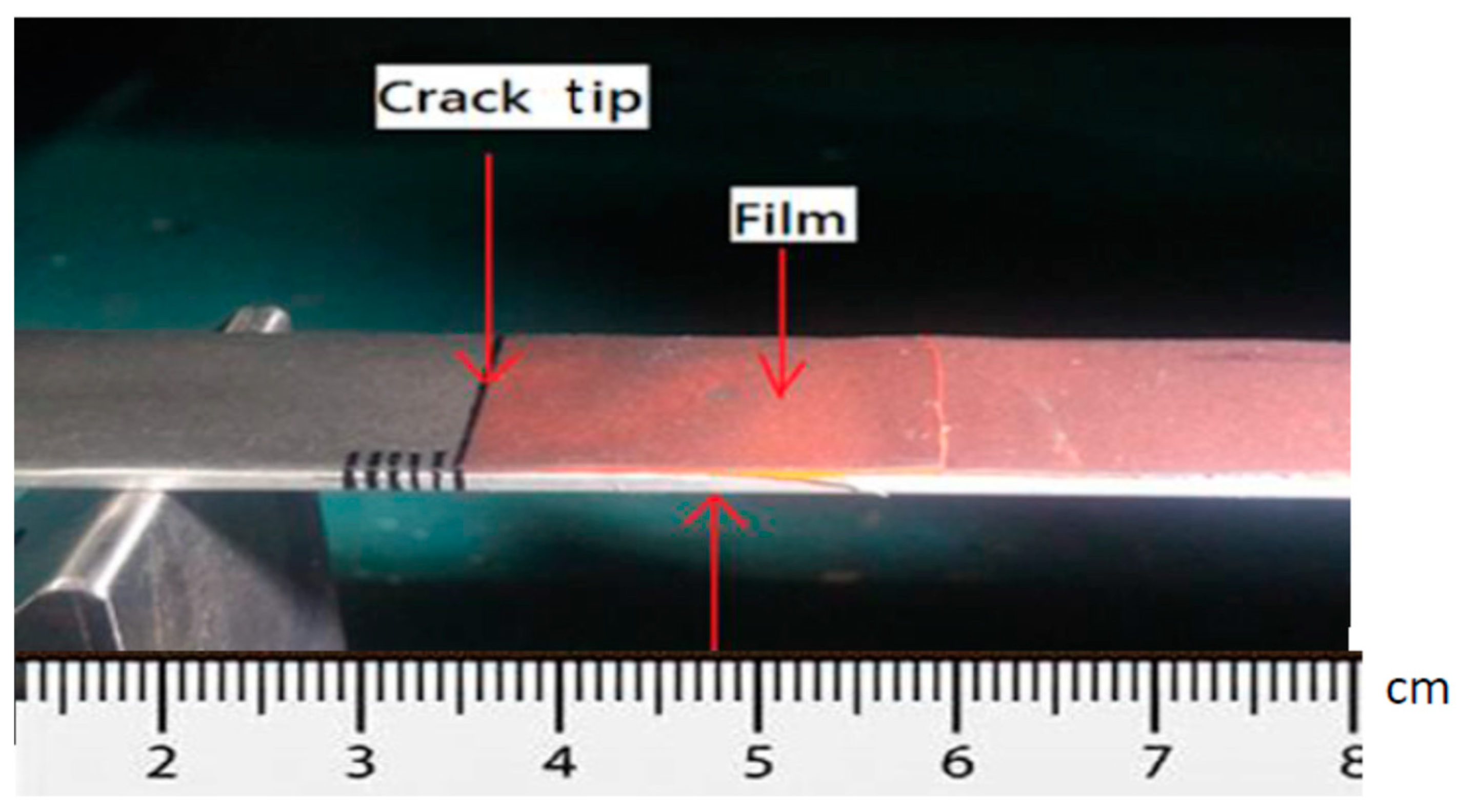
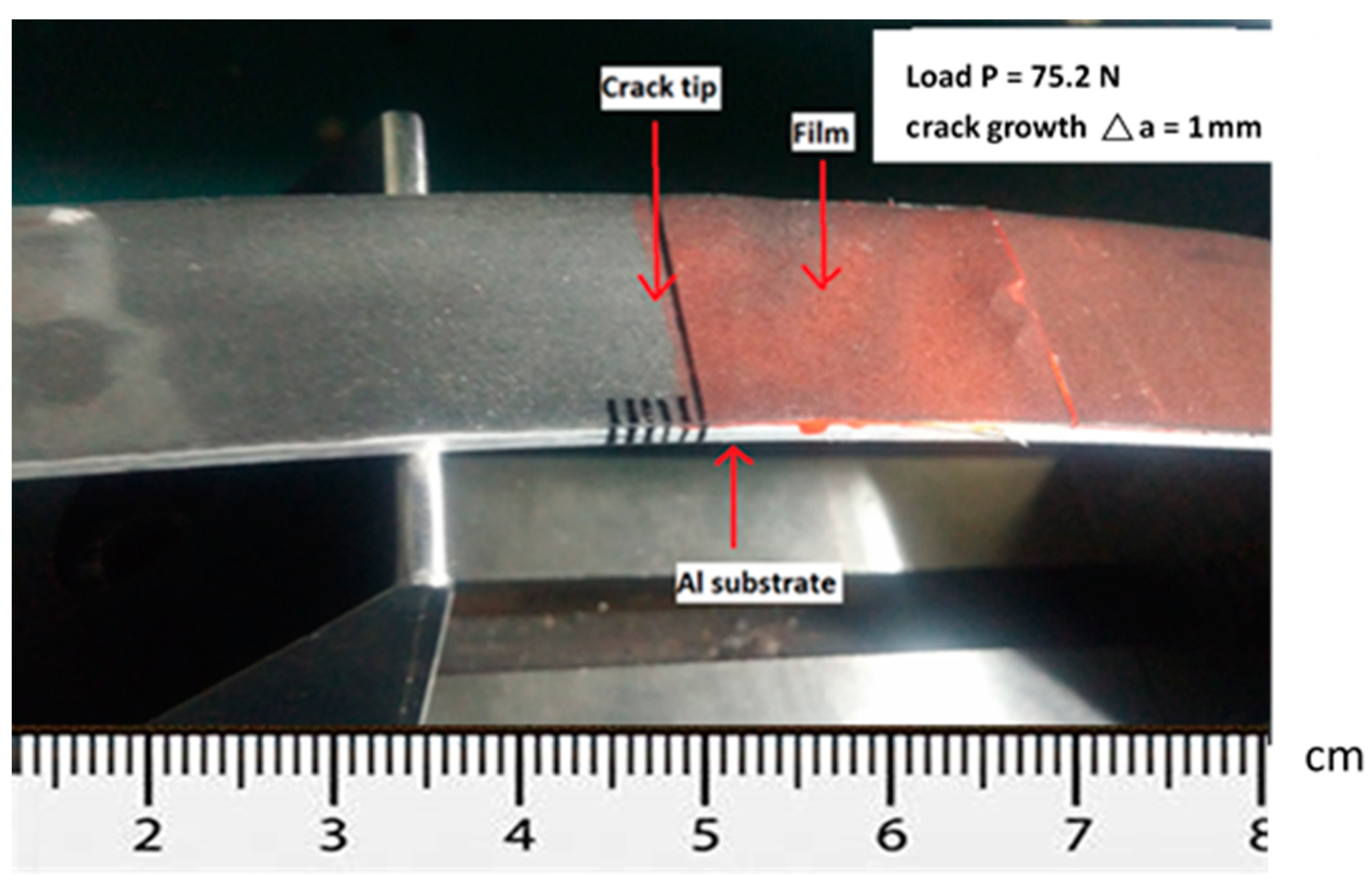
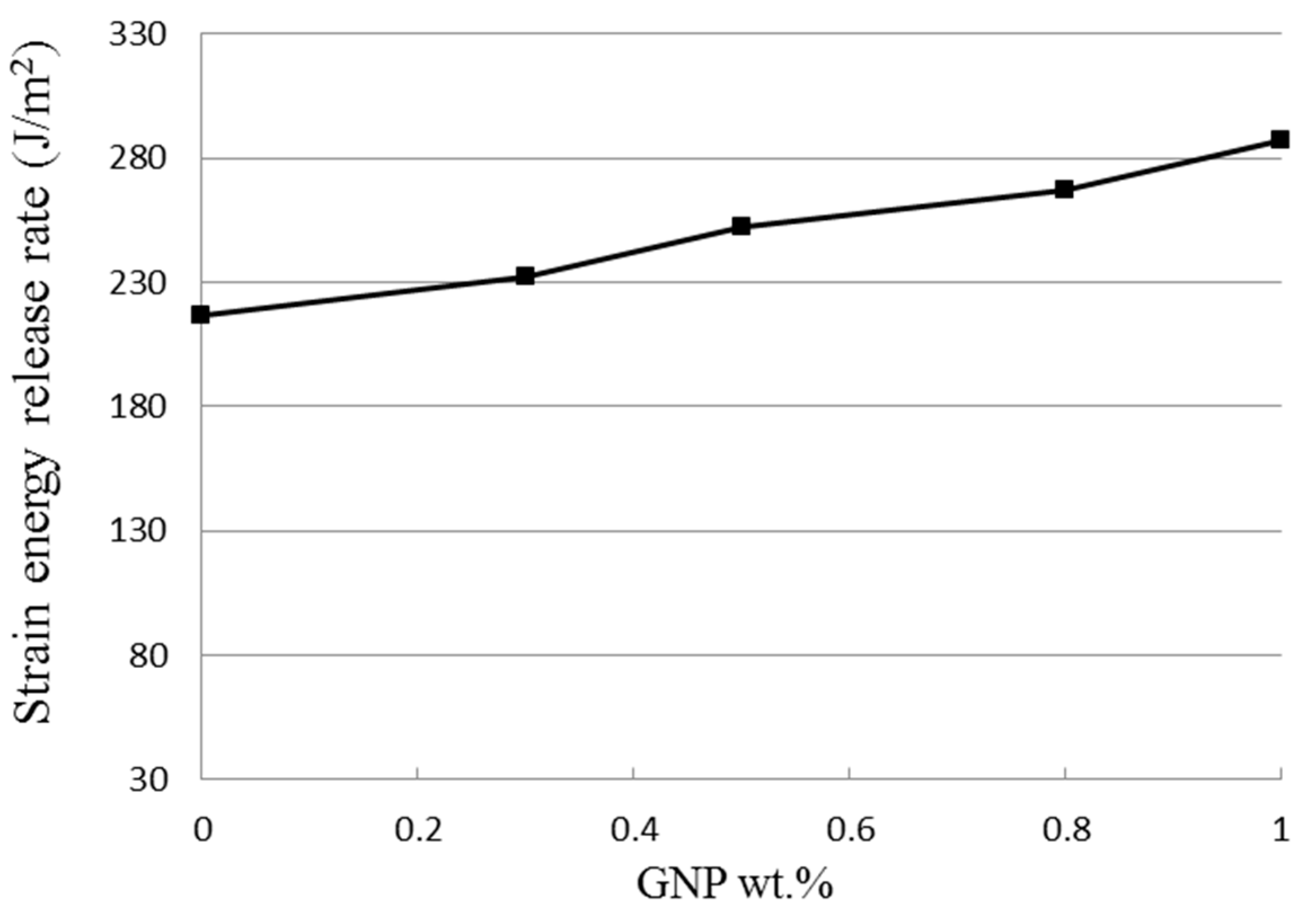
| Tensile Properties | Neat Epoxy | Nanocomposites | |||
|---|---|---|---|---|---|
| 0.3 wt.% GNP | 0.5 wt.% GNP | 0.8 wt.% GNP | 1.0 wt.% GNP | ||
| Elastic modulus (GPa) | 1.99 | 2.33 | 2.49 | 2.69 | 2.83 |
| Yield strength (MPa) | 31.56 | 35.82 | 37.04 | 38.86 | 40.13 |
| Tensile strength (MPa) | 40.33 | 44.75 | 48.24 | 49.87 | 51.16 |
| Fracture strain | 0.0414 | 0.0308 | 0.0285 | 0.0276 | 0.0268 |
| GNP wt.% | Specimen 1 | Specimen 2 | Specimen 3 | Average Strain Energy Release Rate (J/m2) | |||
|---|---|---|---|---|---|---|---|
| Critical Load (N) | Strain Energy Release Rate | Critical Load (N) | Strain Energy Release Rate | Critical Load (N) | Strain Energy Release Rate | ||
| (J/m2) | (J/m2) | (J/m2) | |||||
| 0% | 68.6 | 216.14 | 72.8 | 218.12 | 70.6 | 216.66 | 216.97 0.83 |
| 0.3% | 75.2 | 233.52 | 74.4 | 231.25 | 77.5 | 232.65 | 232.47 1 |
| 0.5% | 83.2 | 251.63 | 86.5 | 251.21 | 86.1 | 253.39 | 252.07 0.86 |
| 0.8% | 89.5 | 266.21 | 89.2 | 265.83 | 92.5 | 266.47 | 267.17 1.34 |
| 1% | 103.1 | 285.65 | 99.5 | 288.56 | 101.2 | 285.52 | 286.58 1.98 |
Publisher’s Note: MDPI stays neutral with regard to jurisdictional claims in published maps and institutional affiliations. |
© 2021 by the authors. Licensee MDPI, Basel, Switzerland. This article is an open access article distributed under the terms and conditions of the Creative Commons Attribution (CC BY) license (https://creativecommons.org/licenses/by/4.0/).
Share and Cite
Her, S.-C.; Zhang, K.-C. Mode I Fracture Toughness of Graphene Reinforced Nanocomposite Film on Al Substrate. Nanomaterials 2021, 11, 1743. https://doi.org/10.3390/nano11071743
Her S-C, Zhang K-C. Mode I Fracture Toughness of Graphene Reinforced Nanocomposite Film on Al Substrate. Nanomaterials. 2021; 11(7):1743. https://doi.org/10.3390/nano11071743
Chicago/Turabian StyleHer, Shiuh-Chuan, and Kai-Chun Zhang. 2021. "Mode I Fracture Toughness of Graphene Reinforced Nanocomposite Film on Al Substrate" Nanomaterials 11, no. 7: 1743. https://doi.org/10.3390/nano11071743
APA StyleHer, S.-C., & Zhang, K.-C. (2021). Mode I Fracture Toughness of Graphene Reinforced Nanocomposite Film on Al Substrate. Nanomaterials, 11(7), 1743. https://doi.org/10.3390/nano11071743





